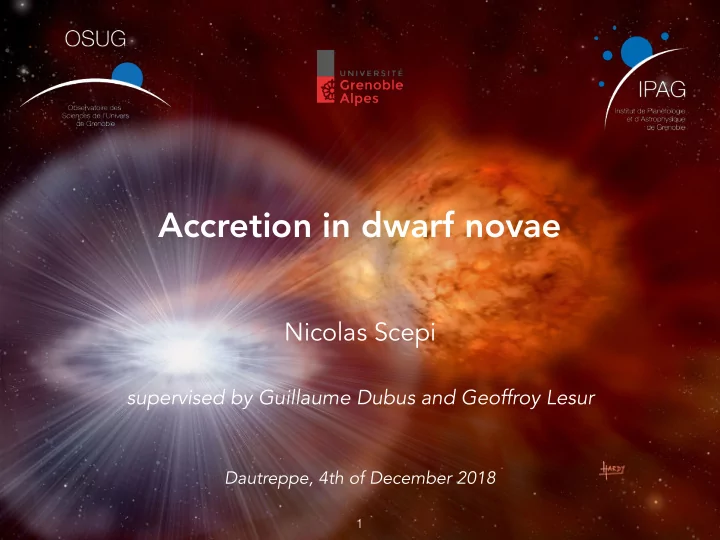

Accretion in dwarf novae Nicolas Scepi supervised by Guillaume Dubus and Geoffroy Lesur Dautreppe, 4th of December 2018 1
Dwarf novae Accretion disk Solar type star White dwarf Dwarf novae are ideal to study accretion : - emission in the visible, UV - access to structure of the disk via eclipse mapping - high variability with time scales going from seconds to months 2
Variability in dwarf novae (DNe) e d u t i n g a M Days Cannizzo et al 2010 Luminosity coming from the accretion in the disk. (Shakura & Sunyaev 1973) 3
Historical framework : Turbulent/viscous accretion Companion WD Angular momentum transport Accretion turbulence Accretion disk Turbulent transport modeled as a viscous transport (Shakura & Sunyaev 1973) ν e ff = α c s H where turbulence is supposedly due to MRI. (Balbus & Hawley 1991) 4
Disk instability model (DIM) Magnitude Days Cannizzo et al 2010 2 t therm = 1 α Ω ( H ) t vis = 1 R Mass accretion rate (or α Ω · M external Temperature) Eruptive state ⍺ ~ 0.1 (Kotko & Lasota 2012) Quiescent state ⍺ ~ 0.01 (Cannizzo et al. 2012) S-curve from the DIM 5
Disk instability model (DIM) Magnitude Days Cannizzo et al 2010 2 t therm = 1 α Ω ( H ) Mass accretion rate t vis = 1 R · M external α Ω Eruptive state ⍺ ~ 0.1 (Kotko & Lasota 2012) Quiescent state ⍺ ~ 0.01 (Cannizzo et al. 2012) S-curve from the DIM Can MRI give these values of ⍺ ? 6
Shearing box simulations Compute ⍺ from the simulations !! 7
Magnetic configuration B z B z Zero Net Flux (ZNF) Net Flux 8
Magnetic configuration ⍺ depends on B z ⍺ does not depend on Bz ( Hawley et al. 1996,Simon et al. 2012 ) (Hawley et al. 1995) B z B z Zero Net Flux (ZNF) Net Flux 9
Overview 1) Zero Net Flux simulations 2) Net Flux simulations 3) Disk-wind model 10
Overview 1) Zero Net Flux simulations 2) Net Flux simulations 3) Disk-wind model 11
Light curves from Zero Net Flux simulations Coleman et al. 2016 Using ⍺ ~0.1 for eruptive state ⍺ ~0.01 for quiescent state Coleman et al. 2016 Using ⍺ from simulations (Hirose et al. 2014, Scepi et al. 2018a) Do not match observational light curves ! 12
Resistive cold branch Scepi et al. 2018a When we include resistivity MRI is quenched in the quiescent state (as predicted by Gammie & Menou 1998) . Yet, there is observational evidence that DNe in quiescence accrete (Mukai et al 2017). 13
Overview 1) Zero Net Flux simulations 2) Net Flux simulations 3) Disk-wind model 14
Net flux simulations WD Companion Transport of angular momentum Accretion disk turbulence Accretion { · · = M R ϕ M Mass accretion rate due to turbulent transport. 15
Outflows WD Companion Transport of angular momentum Accretion disk turbulence Accretion outflows { { · · · = + M z ϕ M R ϕ M Mass accretion rate due Mass accretion rate due to turbulent transport. to wind-driven transport. 16
Turbulent VS wind-driven accretion 0 . 5 C = 6 , β < 10 4 10 7 C = 3 . 5 , β < 10 4 0 . 4 C = 2 , β > 10 4 0 . 3 Viscously 10 6 driven Eruptive state dominated 0 . 2 by viscous accretion 0 . 1 10 5 M Z φ ) M R φ ˙ ˙ β 0 . 0 log 10 ( 10 4 − 0 . 1 Quiescent state − 0 . 2 dominated by the wind- 10 3 − 0 . 3 driven accretion Wind-driven − 0 . 4 10 2 − 0 . 5 10 − 2 H / R Scepi et al. 2018b 17
A new framework WD Companion Disk with a wind will not behave as an ⍺ - disk. Angular momentum transport Accretion turbulence Accretion disk Need to review observational WD Companion constraints with a disk-wind model. Transport of angular momentum turbulence Accretion Accretion disk outflows 18
Overview 1) Zero Net Flux simulations 2) Net Flux simulations 3) Disk-wind model 19
A new disk-wind instability model WD Companion Transport of angular momentum Accretion disk turbulence Accretion outflows We used prescriptions on α ( β ), q ( β ) from our simulations to construct a new DIM. We used a fixed magnetic field configuration. 20
B dipolar Stable case Scepi et al. 2018c in prep · M external = 3 × 10 17 g s − 1 , R out = 2 × 10 10 cm 21
B dipolar Unstable case Scepi et al. 2018c in prep Scepi et al. 2019 in prep · M external = 1 × 10 16 g s − 1 , R out = 2 × 10 10 cm 22
Observations vs Model Magnitude Days Cannizzo et al 2010 For a dipolar moment of ~10 30 G cm 3 , light curves are very similar to that of DNe! However, we used a fixed magnetic field. We need to compute the evolution of the magnetic field . Scepi et al. 2018c in prep 23
Conclusions • Turbulent MRI transport alone cannot explain the behavior of DNe • Net Flux simulations show that outflows transport angular momentum very efficiently in the quiescent state • Taking into account turbulent and wind-driven transport, we can reproduce light-curves of DNe 24
Thank you for your attention 25
Recommend
More recommend